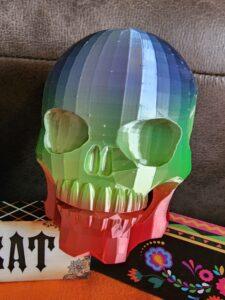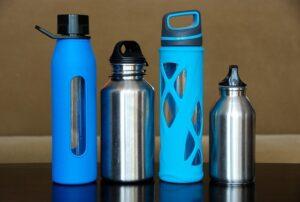3D printing filaments are a type of plastic used in a 3D printer to create three-dimensional objects.  Different types of 3D printing filaments are available on the market, each with unique properties. PLA, ABS, and PETG are all popular choices for filament, but what’s the difference between them?
Different types of 3D printing filaments are available on the market, each with unique properties. PLA, ABS, and PETG are all popular choices for filament, but what’s the difference between them?
PLA is made from corn starch and is biodegradable. It’s perfect for environmentally friendly projects. ABS is made from petroleum and has a higher melting point than PLA, making it more durable.
PLA filaments are a type of plastic used in 3D printers to create three-dimensional objects. Different kinds of PLA filaments are available on the market, each with unique properties.
Some advantages of using PLA filament include that it is biodegradable, has a lower melting temperature, and is less smelly when compared to other types of plastics.
However, some disadvantages exist; for example, PLA can be more brittle than other types of filaments and may not be food safe.

If you’re planning to use 3D printing filaments for your models, it’s important to know that the process isn’t simple. Printing 3D objects can be challenging, and it’s crucial to understand that not all filaments are the same.
However, once you’re aware of all the factors, the process becomes much more painless. 3D printing is a complex hobby that involves sophisticated machinery, computer programming, and 3D modeling. In addition, purchasing a printer, filament, and other accessories can be expensive.
It’s not surprising that beginners may find 3D printing intimidating. But what if you could skip the hassle? For instance, could you purchase a 3D printer that already comes with 3D printing-ready filament?
3D Printing Filaments: PLA vs. ABS vs. PETG
When it comes to 3D printing filaments, there are three main types that are most popular: PLA, ABS, and PETG. Each type has its own unique properties and is best suited for different applications.
PLA
PLA, or polylactic acid, is the most common type of 3D printing filament. It is made from renewable resources, such as corn starch, and is biodegradable. PLA is also non-toxic and safe to use, making it a good choice for educational and hobbyist applications.
Pros of PLA:
* Easy to print
* Non-toxic and safe
* Biodegradable
* Affordable
* Wide range of colors and finishes available
Cons of PLA:
* Not as strong as ABS or PETG
* Not as heat-resistant as ABS or PETG
* Can warp or deform when exposed to high temperatures
ABS
ABS, or acrylonitrile butadiene styrene, is a more durable type of 3D printing filament than PLA. It is also more heat-resistant and can be used to create objects that will need to withstand more wear and tear. ABS is not as easy to print as PLA, but it is still a good choice for many applications.
ABS filaments have some downsides: they have an unpleasant, burning plastic smell while printing and tend to warp or split while cooling.
These issues may not be deal breakers for you, however, and ABS definitely has its uses. A heated print bed is recommended to use with ABS filaments.
Pros of ABS
* Strong and durable
* Heat-resistant
* Can be used to create objects that will need to withstand wear and tear
* Wide range of colors and finishes available
Cons of ABS:
* Not as easy to print as PLA
* Can be toxic, and fumes can be harmful if inhaled
* Not biodegradable
PETG
PETG, or polyethylene terephthalate glycol, is a newer type of 3D printing filament that offers a good balance of strength, durability, and ease of printing.
It is more resistant to heat and chemicals than PLA, but it is not as brittle as ABS. PETG is a good choice for a variety of applications, including functional prototypes and end-use parts.
PETG (Polyethylene Terephthalate Glycol) This filament is an interesting variation on ABS and PLA. PETG is the same plastic as clear bottles and containers, commonly known as Polyethylene Terephthalate.
PETG is a bioplastic similar to PLA but with less warping. Since PETG is a more advanced version of ABS, it can be used with standard ABS print settings.
In fact, there is often no need to change any of the parameters or the print settings when changing from ABS to PETG. This allows you to quickly switch between materials.
Pros of PETG:
* Strong and durable
* Heat-resistant
* Chemical-resistant
* Easy to print
* Wide range of colors and finishes available
Cons of PETG:
* Not as impact-resistant as ABS
* It Can be difficult to get smooth finishes
* Not as flexible as TPU
Which Type of Filament is Right for Your Project?
If you need a filament that is strong and durable, ABS is a good option. And if you need a filament that is heat-resistant and chemical-resistant, PETG is a good choice.
Ultimately, the best way to choose the suitable filament for your project is to experiment with different types and see what works best for you. Creality Canada Student Discount-40% Off
The best type of filament for your project will depend on the specific requirements of your project. If you are not sure which type of filament to choose, it is always a good idea to consult with a 3D printing expert.
Here are some factors to consider when choosing a 3D printing filament:
- Strength: How strong does the object need to be?
- Durability: How durable does the object need to be?
- Environment: Where will the object be used?
- Cost: How much are you willing to spend on the filament?
- Availability: Is the filament easy to find?
Once you have considered these factors, you can choose the best type of filament for your project. Creality US STORE: 50% Off Sale for Students Only
Thanks,
Bullwinkle

